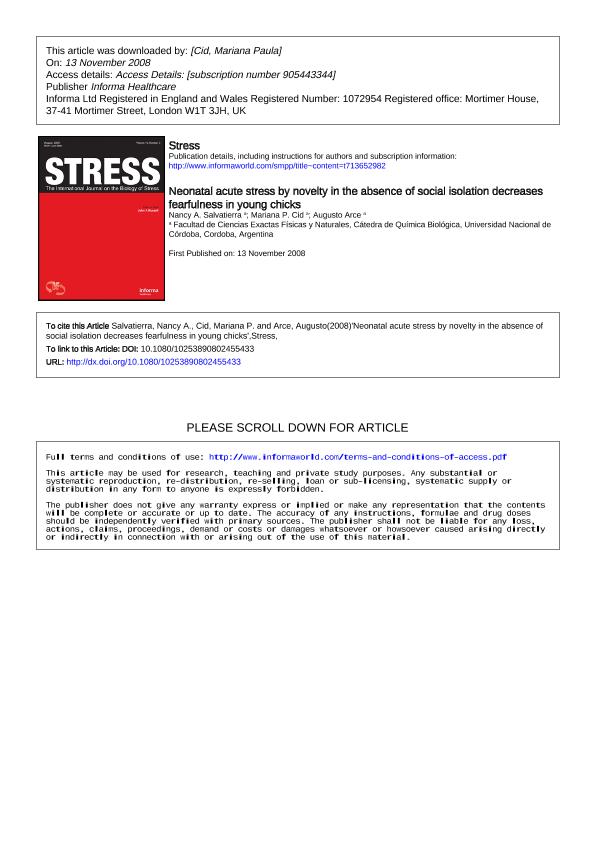Mostrar el registro sencillo del ítem
dc.contributor.author
Salvatierra, Nancy Alicia

dc.contributor.author
Cid, Mariana Paula

dc.contributor.author
Arce, Augusto

dc.date.available
2018-10-09T19:20:35Z
dc.date.issued
2008-11-13
dc.identifier.citation
Salvatierra, Nancy Alicia; Cid, Mariana Paula; Arce, Augusto; Neonatal acute stress by novelty in the absence of social isolation decreases fearfulness in young chicks; Taylor & Francis Ltd; Stress; 12; 4; 13-11-2008; 328-335
dc.identifier.issn
1025-3890
dc.identifier.uri
http://hdl.handle.net/11336/62013
dc.description.abstract
Two hours after hatching (Day 0), groups of chicks from both sexes were housed either individually (IND) or socially in pairs (SOC) for 24 h. On Day 1, for each of the two conditions, half of the chicks were individually exposed to early novelty for 10 min, which comprised being placed in a novel-cage with small pebbles glued to the floor. The other half (controls) remained in the home-cage (IND-C and SOC-C). Thus, the IND-N group was exposed to early novelty, and the SOC-NI group was exposed to early novelty and social isolation. Subsequently, all groups were mixed and socially reared until reaching 15 days of age. At this time, chicks were exposed to open field (OF) and tonic immobility (TI) tests. The IND-N group showed a shorter latency to ambulate in the OF test, shorter immobility duration in the TI test, a reduced plasma corticosterone concentration and increased flunitrazepam sensitive-GABAA receptor basal forebrain density compared with other groups, indicating that a neonatal novelty induced lower fearfulness in young chicks. In contrast, the effect of neonatal novelty was abolished by a simultaneous effect of social isolation in the SOC-NI group. Thus, early post-hatch life events such as early novelty could improve a bird's later ability to cope with new stressful events. In addition, it is possible that both novelty and social isolation act on different neurobiological processes.
dc.format
application/pdf
dc.language.iso
eng
dc.publisher
Taylor & Francis Ltd

dc.rights
info:eu-repo/semantics/openAccess
dc.rights.uri
https://creativecommons.org/licenses/by-nc-sa/2.5/ar/
dc.subject
Early Novelty
dc.subject
Early Social Isolation
dc.subject
Gabaa Receptor
dc.subject
Gallus Gallus Domesticus
dc.subject
Later Fearfulness
dc.subject
Plasma Corticosterone
dc.subject.classification
Medicina Critica y de Emergencia

dc.subject.classification
Medicina Clínica

dc.subject.classification
CIENCIAS MÉDICAS Y DE LA SALUD

dc.title
Neonatal acute stress by novelty in the absence of social isolation decreases fearfulness in young chicks
dc.type
info:eu-repo/semantics/article
dc.type
info:ar-repo/semantics/artículo
dc.type
info:eu-repo/semantics/publishedVersion
dc.date.updated
2018-07-11T17:48:29Z
dc.identifier.eissn
1607-8888
dc.journal.volume
12
dc.journal.number
4
dc.journal.pagination
328-335
dc.journal.pais
Reino Unido

dc.journal.ciudad
Londres
dc.description.fil
Fil: Salvatierra, Nancy Alicia. Consejo Nacional de Investigaciones Científicas y Técnicas. Centro Científico Tecnológico Conicet - Córdoba; Argentina. Universidad Nacional de Córdoba. Facultad de Ciencias Exactas, Físicas y Naturales; Argentina
dc.description.fil
Fil: Cid, Mariana Paula. Consejo Nacional de Investigaciones Científicas y Técnicas. Centro Científico Tecnológico Conicet - Córdoba; Argentina. Universidad Nacional de Córdoba. Facultad de Ciencias Exactas, Físicas y Naturales; Argentina
dc.description.fil
Fil: Arce, Augusto. Universidad Nacional de Córdoba. Facultad de Ciencias Exactas, Físicas y Naturales; Argentina
dc.journal.title
Stress

dc.relation.alternativeid
info:eu-repo/semantics/altIdentifier/url/https://www.tandfonline.com/doi/abs/10.1080/10253890802455433
dc.relation.alternativeid
info:eu-repo/semantics/altIdentifier/doi/https://dx.doi.org/10.1080/10253890802455433
dc.relation.alternativeid
info:eu-repo/semantics/altIdentifier/url/https://www.ncbi.nlm.nih.gov/pubmed/19005874
Archivos asociados
